What are autochthonous grape varieties and which are the most popular
Grapes are grown not only for food or sale, but also for the production of wines, juices, compotes, champagne. Many people dream of a home winery. To get a rich grape harvest, it is not enough to pay attention to the ripening period and care requirements - experienced growers advise to study autochthonous varieties. We will tell you what this means and which autochthonous Russian varieties are the most productive.
The content of the article
Autochthonous grape varieties - what does it mean
There are varieties that are grown only in a certain area. Such grapes are called autochthonous. It appeared naturally in a specific area, therefore it is sometimes called local or aboriginal.
Most varieties are technical or universal - they are used to make wines. According to the taste of the drink, professionals determine the growing region, ripening period and climatic conditions.
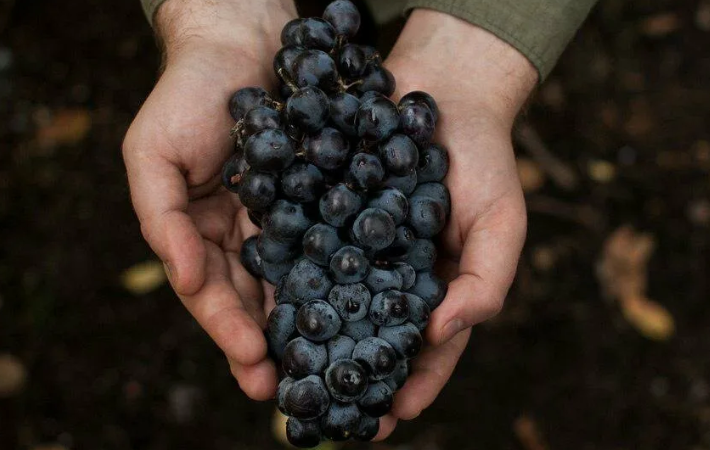
Top best
Italy, Russia, Georgia, Spain - each of these countries is famous for its autochthonous grape varieties. Next, let's look at the most popular ones.
Cortese

Italian white grape variety. Early maturing, demanding for heat, therefore it is grown mainly in the southeastern part of the Piedmont region.
For planting, they construct hilly and windless areas. Bushes are tall, vines ripen quickly. The cluster is larger than average, the structure is dense. The leaves are medium, dark green with light veins. The shape of the berries is elliptical. The skin is light golden, with a slight waxy bloom. Diseases and pests of grapes are slightly affected.
Wine from Cortese turns out to be tart, acidic, with a noble aroma. The drink is consumed within three years after the harvest, later the wine loses its original taste.
Verdejo
The Verdejo grape is grown in Spain, used to make white wines. In terms of ripening, it is late-ripening. Harvested in September, at night, so that the rays of the sun do not burn the delicate berries. Vines of strong vigor, vigorous, medium leaves, no pubescence. The berries are small, white-golden, the flesh is firm and juicy.
The taste is interesting, with a touch of nutmeg, fennel and fruit, light. Verdejo has a strong grape aroma, which is also transferred to the drinks. The yield depends on the growing conditions, so the growers follow all the recommendations for care: make balanced feeding, organize drip irrigation and hold an annual pruning.
Albariño
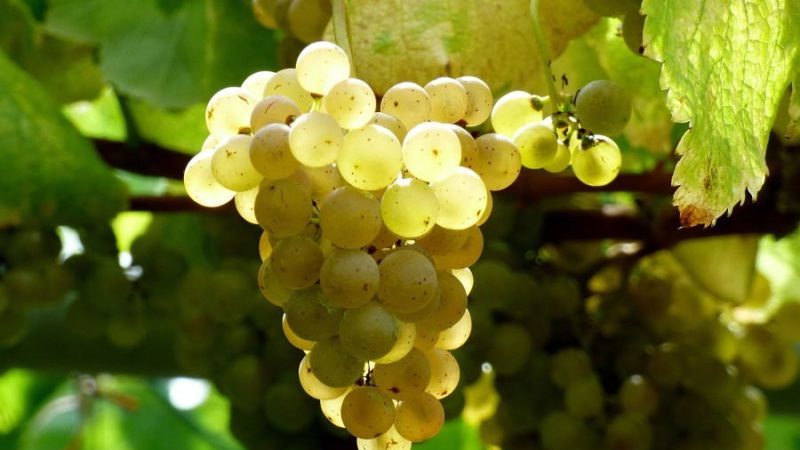
The Spanish grape Albariño does not have a high yield, but, nevertheless, is popular due to its delicate berry flavor... Bushes of medium vigor adapt well to the climatic conditions of the region; berries rarely rot or spoil. Their shape is rounded-elongated, the flesh is fleshy, amber in color, the taste is berry-fruity with a citrus flavor, the skin is strong. The bunches are located close to each other. Sugar content and acidity are high.
Albariño produces delicious wines with notes of lime, orange blossom, jasmine, peach, passionfruit.
Interesting! The world leader in the number of autochthonous varieties is Italy. In this country, there are about 400 of them. In Russia, experts identify about 100. Most of them are located in the Crimean lands, in the Kuban and in the Stavropol Territory.
Krasnostop Zolotovsky
A mid-season technical variety is grown in the Rostov region and Krasnodar Territory... Ripening period - 125-135 days. The bushes are medium-sized, the shoots ripen together. The leaves are rounded, small, slightly wrinkled. Bunches are conical, medium density, loose. The berries are dark blue with a waxy coating, sometimes they acquire a purple hue. The skin is of medium thickness, the flesh is firm and juicy.
Krasnostop Zolotovsky is unpretentious in cultivation, frost-resistant, it is rarely affected by insects and fungal diseases. The grapes are harvested in September, the berries do not crack after ripening, but you should not delay the collection. Red table wines are prepared from grapes.
Saperavi
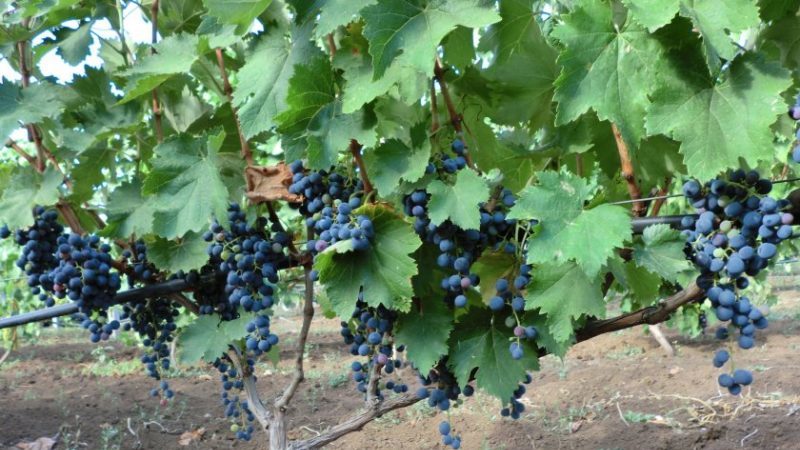
A productive and unpretentious Saperavi grape variety is grown in Georgia. Branching and spreading bushes require a lot of light and heat. The leaves are round-ovate, rich green. The flowers are bisexual, which has a positive effect on the yield. The average weight of a bunch is 150 g, the color is dark blue with a thick waxy bloom. The pulp is juicy and tasty, aromatic. Each berry contains 1-2 seeds. Saperavi ripens late, about 160 days. Frost resistance - up to -20 ° С, good drought resistance. Immunity against fungal and bacterial diseases is average.
Interesting! Ripe Saperavi grapes are consumed fresh or used to make red table wine. The drink has a rich bouquet of taste and dark color. The taste of wine is revealed within four years from the date of production. Wine is stored for up to 50 years.
Nebbiolo
Nebbiolo is grown in Italy. It is appreciated for its aroma and flavor characteristics. The taste of the grapes resembles an assortment of cherries, plums, roses and violets. Ripening period - late. The buds are formed in early April and the fruits are harvested in late October, in foggy and cool weather. Spreading plants, medium vigor. The leaves are deep green, dissected. The berries are small, round, blue-violet, matte.
The variety is resistant to rot and mildew, but is often attacked by phylloxera. Nebbiolo wines are highly acidic.
Rkatsiteli
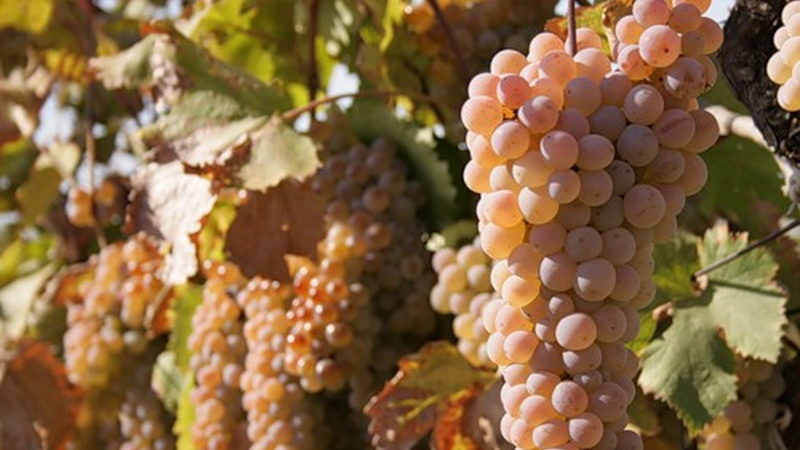
The Georgian grape variety Rkatsiteli is distinguished by tall pyramidal bushes, straight brown shoots, and slightly dissected leaves. The clusters are long, oval in shape. Berries are golden in color with brown sun spots. Fruits are small or medium, weighing 2-4 g. The weight of the bunch is about 170 g. The ripening period is late, the growing season lasts 150-160 days. The variety is frost-resistant, but drought resistance is weak.
Of the shortcomings of Rkatsiteli, they distinguish a strong susceptibility to gray rot, oidium. Also, frequent guests on the plants are spider mites and bunchworms. The taste of the berries is pleasant, moderately sweet. Rkatsiteli is used to prepare grape juice, table wines, and wine materials.
Siberian
The technical variety is grown in Russia. The leaves are large, wrinkled or slightly smooth. The bunches are winged, cylindrical, reach 20 cm in length, weigh about 150 g. The berry weighs about 2 g, has a greenish-white color, oval in shape. Sibirkovsky ripens on average in 130 days.
Varietal light wines are prepared from it, characterized by medium acidity and a light greenish tint. Sibirkovsky rarely gets sick, has a strong immunity to diseases and pests. It is unpretentious to growing conditions, the yield is stable.
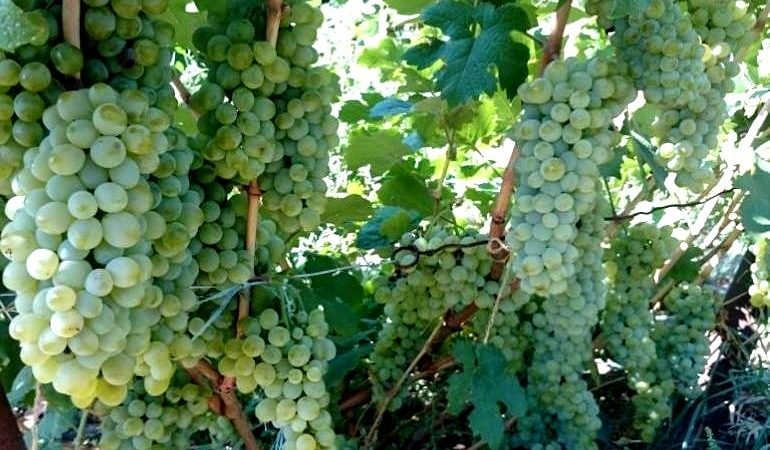
The best early-ripening, mid-ripening, late-ripening grape varieties
- Of early maturing varieties celebrate Primitivo - red grapes with rich taste and aroma. It is grown in southern Italy, used to make red wine, which has a scent of fruits and spices. Plant of medium vigor with dark green leaves. The variety is early maturing, the harvest is harvested in early August. The bunches are large and dense, the berries are small, black and blue. Primitively unpretentious to soil and climate, it is affected by diseases in an average degree. It is used to make red fruit wines.
- St. Laurent is distinguished from mid-season autochthonous varieties.... Grows in Austria.Leaves are medium in size, wavy. The bunches are cylindrical, winged. The berries are compact, deep blue-black. The pulp is juicy and firm, pleasant to the taste, suitable for fresh consumption. St. Laurent is picky about the composition of the soil, sensitive to frost. Red wines with notes of sweet and sour cherries are prepared from it.
- Popular Sangiovese grape variety characterized by late ripening and amicable fruiting. Drinks from this variety are obtained with notes of chocolate, prunes and vanilla. Sangiovese grows in Italy, it is distinguished by tall shrubs and dark purple fruits. The berries are small, rounded, the skin is dense with a bluish bloom. The taste is high in acidity. The flowers are bisexual, the vines are dark brown.
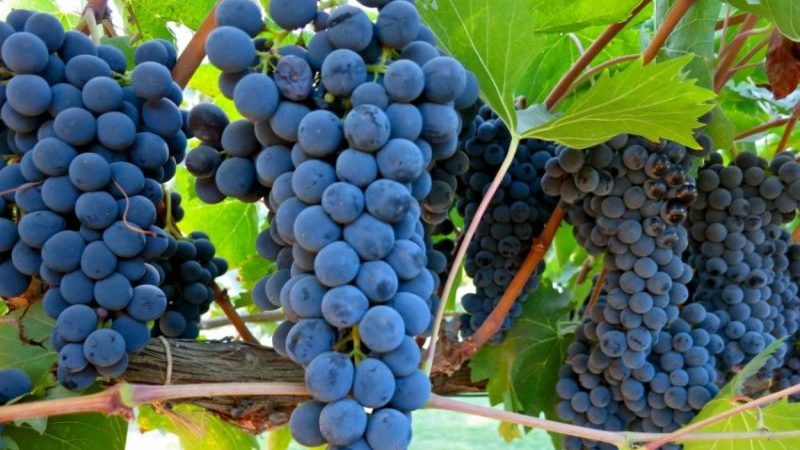
White, dark, pink
- White grade Ag Raisin appeared in Dagestan. Prefers fertile soils, sunny areas. The leaves are small, rounded with sharp edges. Clusters are medium in size, conical and loose. The berries are oval-rounded, with a thin green-yellow skin. The ripening period of the variety is average - from 120 to 135 days. Frost and drought resistance are average. Ag Raisins are used for making raisins, juices and compotes. The advantages include high portability.
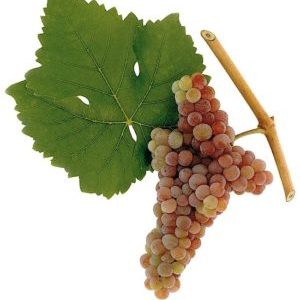 Zierfandler
Zierfandler - Pechistik - old Don wine variety of dark grapes. Bushes are medium-sized with rounded-elongated leaves. Cylindrical clusters weigh about 200 g. Fruits are dark blue with a thick waxy coating. The rind is thin but firm. The pulp is of medium density, the juice is colorless. Plechistik has a balanced, sweet and sour taste. It is grown for the production of dry and dessert sparkling wine.
- Pink grape variety Zierfandler cultivated in Austria. The leaves are large, slightly fleecy, have 3-5 lobes. The bunches are medium in size, the fruits are very dense, pressed against each other. Their shape is rounded, the color is light pink with a reddish tint. Zirfandler does not tolerate frost well, so it is grown in well-heated sunny areas. Ripening of shoots is good, flowers are bisexual. Yields vary from medium to high, depending on compliance with the rules of care... The taste is pleasant, with a slight sourness, rich aroma. The purpose of the variety is technical.
Best for different growing regions
- Varyushkin grapes are recommended for cultivation in the Krasnodar Territory and the Rostov Region... It grows successfully on clay soils, the ripening period is 140-150 days. Red dessert wines are made from Varyushkin. The berries are small, purple-red. The taste is delicate with a slight sourness.
- The Kisi variety is also grown in warm regions. Bunches are conical with oval green berries. The skin is thin with a thick waxy coating. The ripening period is about 140 days. The yield is stable. Kisi is used for the preparation of table wines and juices.
- An autochthonous variety is suitable for the North Caucasus Tersky scarlet... It is grown in Chechnya and Dagestan on loamy nutrient lands. The leaves are large, dull, with dense pubescence. The flowers are bisexual, the clusters are wide with small berries. The shape of the fruit is round, the color is dark blue. The pulp of Tersky scarlet is juicy. Ripening period - 140-150 days. The variety is winter-hardy, transportable, and has attractive commercial qualities.
 Scarlet Tersky
Scarlet Tersky - Ivanovsky grapes are grown in the Volgograd region... The variety prefers clay or sandy soils, drought tolerant. Bunches are conical, medium or large. The berries are elongated, dark blue, ripen in 135-140 days. Red dry wines are prepared from Ivanovsky, and the fruits are also suitable for fresh consumption. Harmonious berry taste.
Attention! In cold Russian regions (Ural, Siberia) autochthonous varieties are not grown. They do not take root well and are sensitive to sharp climate changes that are characteristic of these lands.
How to choose an autochthonous grape variety
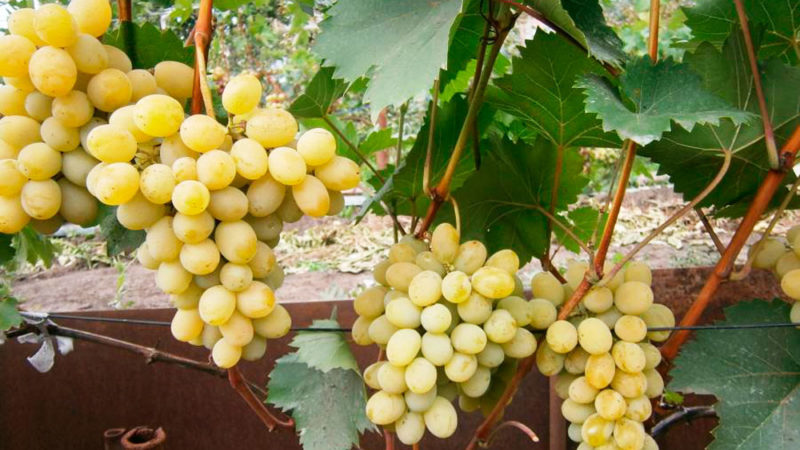
When choosing, it is recommended to pay attention to which regions this or that variety is intended for. The geographic criterion is the most important when it comes to the autochthonous nature of grapes. After that, they are already repelled by external and taste characteristics, ripening periods, resistance to frost, drought, diseases and pests.
The main purpose of autochthonous grapes is the processing and preparation of wine. For dry red, dark and pink varieties with a rich fruit and berry taste and aroma are grown; for white and sparkling wines - white grapes with high acidity.
Conclusion
Cortese, Saperavi, Nebbiolo are the names of popular international autochthonous varieties. They are called autochthonous because they yield crops only in a certain region.
The varieties Krasnostop, Ivanovsky, Terpsky scarlet are popular in Russia. They are grown in the Krasnodar Territory, in the Caucasus, in the Rostov Region. Planting and caring for autochthonous grapes is different from growing ordinary table varieties. It is important to take into account the region and location, harvest time, soil and temperature requirements.